Spearheaded by burgeoning scientific and clinical research literature, psychedelics have reached a level of media coverage and popular interest that has not been seen for over half a century. By “psychedelics,” we are referring to the unique class of substances that includes psilocybin (the active compound found in so-called “magic mushrooms”), LSD, dimethyltryptamine (DMT), ayahuasca, 5-MeO-DMT, and mescaline – each of which occurs in the natural world (except for LSD, which is a semi-synthetic compound).
Las Vegas Performers Give Chiropractic Top Billing
Currently, one of the hottest shows in Las Vegas is Celine Dion's "A New Day," presented in the Colosseum at Caesar's Palace. In addition to Celine Dion, the show features the talents of 48 dancers, 10 musicians and many others. They perform close to 200 shows a year, averaging about five nights a week over 40 weeks. The show features Celine singing 20 songs while the dancers add to a visually stunning performance.
Overseeing the health of all the performers and other members of CDA (Celine Dion Angelio) Productions, Inc., is Trevelynn Henuset, DC, or "Trev" as his patients call him. Trev is the Health Services Department Director for CDA Productions. He makes all health care decisions for everyone in the company. He also coordinates all care with a number of other health care providers as required.
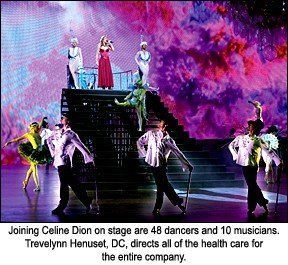
Trev was hired in October 2002 to oversee the health care of the performers in "A New Day." According to Dennis Rodriguez, CDA Productions' company director, Trev "oversees the health insurance program, our workers' comp, and the general health of the entire ... not just the dancers, but the entire company. And that's not only the people that are assigned to CDA, that's also our IATSE (International Association of Theatrical Stage Employees Union) staff. If somebody's not feeling well, they'll go in to see Trev."
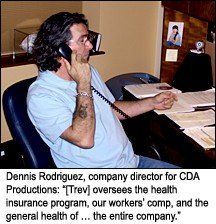
While almost all other Vegas shows utilize a physical therapist as their primary provider for musculoskeletal complaints, CDA Productions took a different course: "I felt that being able to adjust people that get out of alignment would be better for us than just having a physical trainer on staff, so to speak, which I also have on staff," says Dennis.
Tonight's show starts at 8:30 p.m. Trev begins seeing patients at 3 p.m. Spending time as an observer in Trev's "office" is like spending time in Grand Central Station. People are constantly coming in and out. His office is barely wide enough to let him walk all the way around his adjustment table and is only about 10 feet longer.
Two minutes don't go by without someone interrupting him. Most times, it's another performer dropping in to request a spot on the list for last-minute care. Occasionally, it's a phone call from a personal assistant, letting Trev know that another "artist" will be in Vegas next week and wants to see him before they open.
Most of his cases deal with chronic pain. Because he works with the same performers, he knows their needs as well as their ailments. Dancers are his most frequent customers. They must make very specific movements. Any loss of movement is noticed and may prevent the dancer from being able to safely perform his or her "track" - the dance routine for a particular song.
Unlike many patients, the dancers do what they are told when it comes to rehab. If anything, they will tend to overdo it in an effort to get back in the show. In addition to chiropractic care, Trev stresses a strict diet, nutrition and "functional resting." Pain is addressed with ice and adjustments, rather than NSAIDs or other drugs. Dancers need Trev's permission to take any kind of drug, even an aspirin.
"Can the artist do the move?" "Will it be with or without pain?" "Will this loss of movement prevent them from performing a specific track?" These are the questions Trev has to answer every day. Ultimately, there is a meeting with Brian Burke, the dance supervisor, to decide which performers can safely perform that night.

"If we have injuries during the show, or just ongoing reassessments of the individuals, we come to work, meet with Trev, and we sit down and just go through the list, as it were, of injuries and rehab programs, says Burke. "Essentially, Trev makes the recommendations based on where each of the individuals are at in their rehab, or not, and he'll give us the recommendations, and we'll essentially do our lineup. Our show lineup is based on his recommendations.
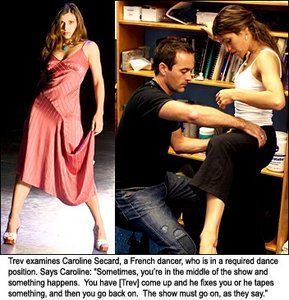
"We rely solely on Trev and his department to inform us, aside from the artists. Because the artists and dancers can say, 'I can do it, I'll do it,' and Trev's the realistic one: 'No, they physically can't, this is making them worse,' or 'It's psychological and they're fine, and they can do it,' which is the truth sometimes in a lot of cases."
Trev takes a very educational approach with his patients. He solicits their input, and then explains what is happening: "How is it today? Is this it or is that it?" He remembers each dancer's complaints, explains what is happening and which bones and muscles are involved. He names the bones and muscles, so the dancers can refer to the bones and muscles by their proper names. He then goes into how the injury is affecting their movements. Sometimes, he has to teach them how to move differently to avoid the pain. "You must work within a pain-free range of motion," he'll tell them.
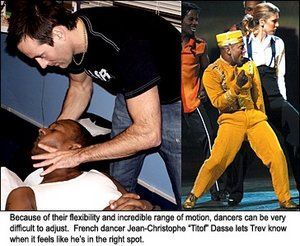
Dancers know their own anatomy. They can detect even a 5-percent loss of movement. A 5-percent gain in movement can take a dancer to a whole new level in his or her dancing.
Jean-Christophe "Titof" Dasse, a dancer from France, explains how he and Trev work as a team when he's adjusted: "We work together, and I was like, 'OK, I think you're right. We're on the right path.' And then he finds the gentle way and the precise way to do it [adjust]. I really like that because, what I want to say is, it's teamwork with Trev. It's really a team. He's not coming in and saying, 'OK, I'm going to do that, you hurt here.' No. It's teamwork. He considers my feedback and from that point, with his knowledge, but sometimes, what is amazing is that sometimes, he's even open to my suggestions - and he's the chiropractor. So this is really smart to be that open to anything, because he's the one that knows, not me. And of course, I respect that so much. So there is a teamwork that is excellent with Trev."
The show takes place on a very large stage that is on a steep incline or "rake" toward the audience. Most people would find it hard to walk, let alone dance on a rake of this magnitude - about twice what is normal. This causes a multitude of problems for the dancers, not to mention the complexities of their dance routines. Through it all, the dancers have nothing but praise for how chiropractic impacts their performance and their carriers.

Sara Montene, another dancer from France, boldly states: "It's helping a lot, of course, because of the show being so intense, and the movements we have to do being so against the body, that we need to get adjusted, and having him all the time here is just making it physical to do it on a daily basis. Here, we have somebody taking care of us right here, and it's such a change compared to all other companies I've been working with. I can feel that even if the stage has a big rake, and the movements that we have to do are thoroughly, really hard, and against the normal body place, everybody stays pretty much in good shape, just because we have a chiropractor here. Other shows ... should have a chiropractor, because I think we need them. We need them to be there and adjust us, and put everything's in place, where it's supposed to be."
Chris Houston, a dancer from Scotland who has been out for three weeks, exclaims: "I think it's really saved my career, to be honest, because we are dancing on such an incline stage that without the chiropractor, I don't think my body would have been able to perform the show. Because of the effects of gravity and the way that you're standing and dancing on the stage, really means that it's easy for your head to drop out or your neck to drop out or your ankle to drop out, and once that goes, then it's really all downhill from there. So for me, it's the best thing. It really is. I'm really, really glad we have a chiropractor."
Because he is onsite during the performances, Trev can assess and address an injury only minutes after it occurs. Caroline Secard, another French dancer, explains: "Almost everything that I did before, I had access to a chiropractor on the spot, so I think it's a good idea. If the company wants to take good care of your dancers, I think it's the best plan to have. Sometimes, you're in the middle of the show and something happens. You have [Trev] come up and he fixes you or he tapes something, and then you go back on. The show must go on, as they say."
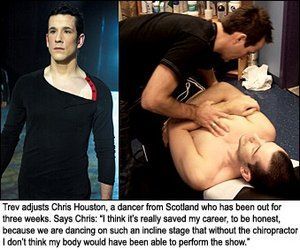
When the show finishes and the audience goes back out to the casinos, Trev returns to his "office" to find a line of anxious patients. Some have incurred an injury during the show that needs further attention. Others just want "one more adjustment," particularly since this is the last show before a much-needed three-week break. Tonight, only six dancers required attention after the show. The list has been as high as 15. Trev hopes to leave by midnight.

Two days later, Elton John and his band open "The Red Piano" show at the Colosseum, on the same stage. As is true with many of the performers that pass through Vegas, Trev has a number of patients in the band. Bob Birch, Elton John's bass player and background vocalist, is one of them. In 1995, Bob was hit by two colliding trucks as he was walking down the street in Montreal. After time in the hospital and in a wheelchair, Bob essentially had to relearn to walk.

While most people believe the life of a rock and roll player is one big party, the reality is far less appealing. "Well, you get up. If we don't have a gig, we have to travel. Get on an airplane, carry your bags, sit and wait. A lot of sitting around, which isn't good for bones that aren't adjusted right, and then if you have to play, you sit around all day until it's 8 o'clock, and then it's like 'Bam' - three and a half hours of intense ... in a fishbowl, people staring at you, music. And then you try and get some sleep, and you start all over again. That's every day."
Bob had C5-C6 fusion surgery two years ago, in addition to the injury from the collision. It was after that surgery that he saw a "chiro" for the first time. "That's when I met Trev." While there is still much that Bob has to overcome, chiropractic has given him great relief. "The stuff that he did was actually having an effect on making me feel better... with what I have going on, that's like a Godsend."
According to Bob, the music community is actually very high on chiropractic: "I think that musicians over the past 10-15 years have really sought out chiropractors. A lot of friends I know have had wrist injuries, and carpal tunnel - things where the [medical] doctors just wanted to operate - and they went to see the chiropractor, and the chiropractor straightened them out. But I think there's a lot of musicians who go to chiropractors. I bet 80 percent of working musicians on the road or in studios go see them. Because there's a lot of tension involved in playing an instrument. And I'm not just talking about rock-and-roll players. I'm talking about classical players, violin players, and all aspects of music."
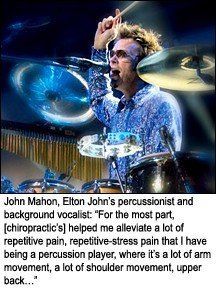
Another one of Trev's patients is John Mahon, who is Elton John's percussionist and also a background vocalist. John sees Trev for chronic pain: "For the most part, it's helped me alleviate a lot of repetitive pain, repetitive-stress pain that I have being a percussion player, where it's a lot of arm movement, a lot of shoulder movement, upper back, and I didn't usually try chiropractic until I went to Trev and he did some things I had never had done before. I stopped taking a lot of pain medications, and he started doing more chiropractic work on me - some stretching and muscle-related work.
"[M]y [medical] doctor in the States, as soon as he looked at [my shoulder], he gave me three shots of cortisone. The next time I went back, he said, 'We should probably go in there and operate.' I think if I wouldn't have tried some chiropractic and physical therapy, I may have gone that route a little sooner. So at this point, it's kept me from getting a hole put in my shoulder."
From his vantage point in the entertainment industry, Trev has some interesting insights about being a doctor of chiropractic and a health services director: "I look at myself as the primary care physician to them, with chiropractic philosophy and the chiropractic way of looking at the body, in opposition to a medical reductionist view, which is what they're usually going to get. So I think that using the advantage that they get, they have the opportunity to have chiropractic first, instead of chiropractic last. I think that's a huge thing. So instead of the first thing they get is a two-week trial of NSAIDs with some PT and see if it goes away, they get a two-week trial of joint mobilization, adjustments, manipulation, tissue therapy, and absolutely no drug therapy. Let's try a nutritional way of working with inflammation instead of a synthetic manmade drug. "I'm facilitating healing in someone else's body. I'm working with them in a teamwork situation. It's a give and go. It's a relationship that I'm generating with them to facilitate health. Essentially, that's what I'm doing.
"You have to have a full spectrum of knowledge. You have to be able to think quickly on the spot. You have to be able to understand 'Is this person actually injured?' 'Are they just freaked out because they're hurt?' 'Do they really want to dance?' 'Do they not want to dance?' On top of having to figure that out, you have to parlay your answer so that you get the best response from them as possible, because you have a show that makes $1 million a night that's going to go on. If you can't make a positive effect on this artist, that's finances. And if you can't do that, you're not going to be around very long.
"I think you have to come from a place where you understand why these people are doing what they're doing, because if you're dealing with dancers and gymnasts, they're not doing it for the money. They're doing it for the love of the art, of what they're doing. When you see their bodies doing things that we could never dream of doing, and you can participate in taking them to that next level, giving them that last five percent, it's a challenge, and it's a beautiful thing to feel involved. And they really appreciate it when you can take them to that next level."



